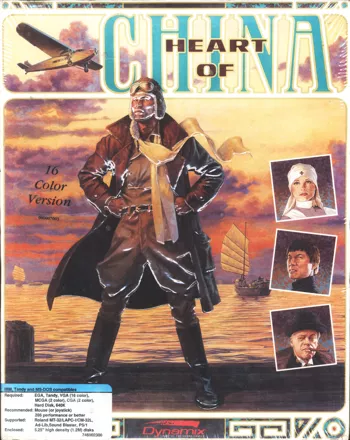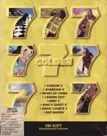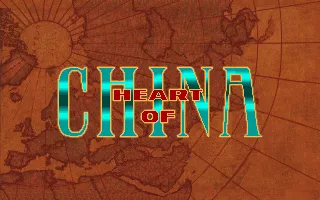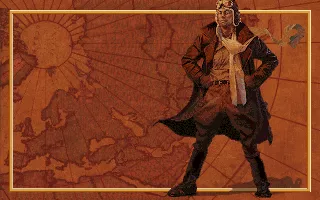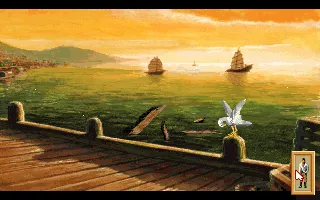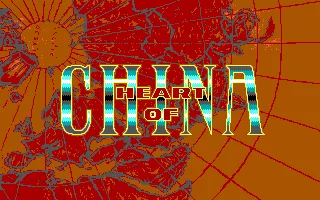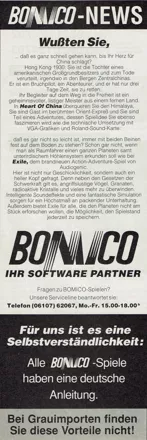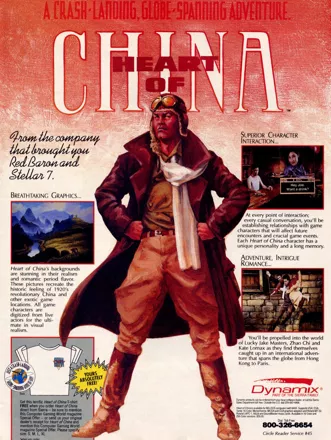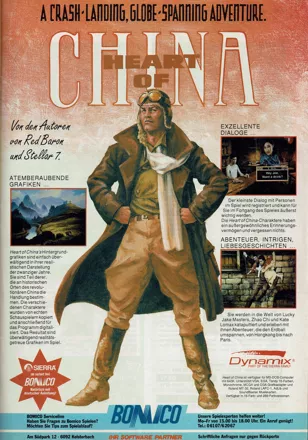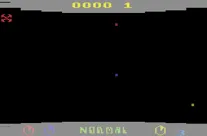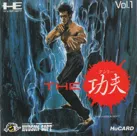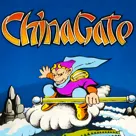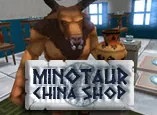Description official descriptions
Kate, the daughter of a wealthy businessman named E.A. Lomax, is abducted by a Chinese warlord named Li Deng near Chengdu, where she was volunteering as a nurse. Lomax recruits the former World War I fighter pilot Jake "Lucky" Masters for a dangerous mission: travel to Hong-Kong, locate a mysterious ninja, and find a way to infiltrate Li Deng's fortress and rescue Kate.
Heart of China is an adventure game with a romantic theme somewhat reminiscent of films such as Raiders of the Lost Ark. The game is set during the 1930's in China as well as a few other locations. It uses a simple point-and-click system for interaction and object manipulation, and is very similar visually and gameplay-wise to Rise of the Dragon.
Some of the tasks in the game have multiple solutions, allowing the player to pursue different methods and choose different responses in branching dialogues. However, some choices may lead to the protagonist's death or bring the investigation to a dead end. There are also a few arcade sequences, which can be skipped if the player fails to complete them after several tries. The game utilizes digitized photos of live actors superimposed on hand-painted graphics.
Spellings
- בלב סין - Hebrew spelling
Groups +
Screenshots
Promos
Credits (DOS version)
119 People · View all
| Designer | |
| Director | |
| Image Production | |
| Lead Programmer | |
| Scene Direction | |
| Lead Production Artist | |
| Artists | |
| DGDS System | |
| Programmers | |
| Orient Express | |
| Tank Sequence | |
| 3D Graphics | |
| [ full credits ] | |
Reviews
Critics
Average score: 78% (based on 25 ratings)
Players
Average score: 3.7 out of 5 (based on 52 ratings with 4 reviews)
The Good
It had a very simple interface and was not very difficult to figure out. I think if I can play a game without a manual, then it can't be all that difficult. The puzzles were fairly decent. If you're not careful, you could end up hitting a brick wall. It was fairly obvious when you might be messing up--you'd get a text message that said "plot branch". When dealing with NPC's, you could give several different answers, which changed the way they responded to you over time (especially Kate, the woman Lucky is sent to rescue). Multiple endings, which depended very much on what you did during the game. Also, it's always nice to be able to play a female character for once, even if it's only for a short part of the game.
The Bad
It treated some characters, especially the Asian ones, very stereotypically. Way too short for my liking. The plot seemed very hackneyed, without an awful lot of depth. I ended up having to reload a lot at first--the initial conversation where you try to find, and then convince, Chi to come with you is difficult. Later conversations are a bit easier to handle--the only other one you can really mess up on is the conversation with the Lama. I really don't like arcade sequences in adventure games, but here, thankfully, you can skip them without hurting the plot any. Kate and Lucky's relationship seemed very rushed--if you notice the time indicators in the game, it takes place apparently within a three day time span. Somehow, I thought it would take longer, especially considering the type of airplane.
The Bottom Line
The game takes place after the first World War. You play a jaded former wartime airplane pilot-turned-shipping courier sent to rescue Kate Lomax, daughter of a wealthy man. With the incentives her father has given you, you really can't say no. This journey begins in China and takes you halfway across the globe to the game's end in Paris.
DOS · by OceansDaughter (106) · 2001
A good adventure for it's time that holds up well.
The Good
The game is played from the first person view which makes it much more involving to play, and gets around the clunky problem with many point and click adventures of the era; having to watch your character plod across the screen.
The graphics are done in a blended photo characters against drawing style, which in this rare example works and creates a believable environment where the style is consistent. This is probably helped by avoiding any animation whatsoever in the cut-scenes, which would betray the actors against a blue-screen. There's also no audio aside from the soundtrack, which is great, voice acting and encoding in this era were generally terrible, so better side-step that until the technology caught up.
The plot is a standard globe-trotting pulp adventure so common to adventure games, complete with cheesy love interest, though it is all told in a fairly cringe free manner. The story-telling is done fairly well, with good dialogue and an interesting ability to approach problems from several different angles, standard fair today, but for the time it's handled smoothly allowing for a more involved sense of storytelling.
The title is a bit of a misnomer as much of the game happens outside of China, but hey it sounds catchy.
The Bad
Whilst the story unfolds fairly well, it does allow you to get stuck in dead ends quite often, though the characters often hint that so you need to save regularly to be able to go back. It falls prey to several cheesy scripting elements, such as dodgy jokes and such in an attempt to make the game feel like a comedy/adventure film such as 'Romancing The Stone'.
The game engine is solid enough though a little fussy to use, you have two methods of calling up the inventory each one acting slightly differently. The arcade elements of the game look out of place, but actually play ok, so no problems there.
The Bottom Line
A light and breezy game, that is simple to play and fairly short. I like games like this whose puzzles take the more logical approach to the point of straying toward the easy side, rather than trying to be fiendishly hard and obstruct the plot. It handles the sound and graphics well for a game of its age and still plays well. Recommended to anyone with some time to spare who wants a quick adventure.
DOS · by RussS (807) · 2009
Dynamix's excellent farewell to the adventure genre
The Good
Heart of China is one of three games that were created by Dynamix, the same team who brought us Rise of the Dragon, a cyberpunk adventure set in the future. HoC is the opposite of this, as we are taken back to the past – to 1920's China. These two game share the same engine. Both are presented in first-person and have the same VCR-style menu.
WWI air ace “Lucky” Jake Masters is called upon by multi-millionaire E.A. Lomax to rescue his daughter, Kate Lomax, who faces imminent danger somewhere in China. He is given $200,000 up-front, but he is deducted $20,000 for every day that he is late rescuing her. Lucky employs the services of ninja Zhao Chi to help with the rescue. Lucky plans to return to Hong Kong and deliver Kate to her father, but things get complicated, and the three characters end up traveling through Asia and dealing with the locals, which may help or hinder them.
Jeff Tunnell, the director, wanted HoC to feel like an interactive movie, and it was so close to one. A cast of over eighty actors were used for the production, and whoever participated had to wear clothes that match the 1920's China setting. Each of the actors were filmed in front of a white screen and then superimposed onto hand-painted backgrounds. Due to a tight budget, the actors were limited to Dynamix employees and their families. Damon Slye, who was the co-founder of Dynamix as well as bringing us Stellar 7, played one of the British officials, for instance. The entire shooting process lasted for over a year, and that coincided with the development of the game system.
They did a good job with the final product, but the only thing missing was spoken dialogue and animated close-ups that go with it, similar to what you see in the CD version of The Adventures of Willy Beamish. They didn't have any trouble with developing an interactive movie, since they first tried it with David Wolf: Secret Agent.
There is also another engine at work called 3-Space, which kicks in when you play the game's first arcade sequence. This is where the graphics are presented in 3-D polygons and the gameplay is reminiscent of Stellar 7. There is another game that takes place on top of the Orient Express, but I just found that difficult unless I go into the VCR menu and set the difficulty to Easy. HoC even lets you save before attempting an arcade sequence. This means even if you finish it, you can go back and replay it if you are sick of adventuring for a while.
The hand-painted backgrounds look amazing, and most of them blend in with the oriental setting. Both the Chengdu countryside and the view of the Himalayan mountains are breathtaking. Sound-wise, the music and sound effects are good enough, but they sound absolutely great if you are using the Roland MT-32. Using this device gives the game more of an oriental feel to it.
I enjoyed playing taking turns playing multiple characters, and these mean that there is more than one way to solve a puzzle. In Chengdu, for instance, you have to find a way inside the fortress by posing as one of the peasants (as Chi) or using a secret passage somewhere in the sewer (as Lucky). Unlike Rise of the Dragon, where multiple paths also existed, the game lets the player know that that puzzle could have been done differently. There is more than one ending, but whatever ending you get depends on the relationship between you and Kate.
Usually, all your actions are performed using the mouse, but you can also play with the keyboard or joystick (if you can put up with the slow pace). The only situation where I could play with the keyboard is when I am playing the arcade games, where controlling your vehicle/character is much easier.
The Bad
If you exactly know what you're doing throughout the game, it can be too short. Also, certain characters remember how you treated them, so choose the wrong dialogue choices and you will have no choice but to restore your saved game and try again.
The Bottom Line
The roots of Heart of China can be traced back to David Wolf: Secret Agent, Dynamix's early game which also has digitized actors and multiple paths. The hand-painted backgrounds are amazing, and the sound is excellent. The multiple paths/endings in this game make the game replayable, so try to go back and play it again and select different choices that will achieve a different result. As for the endings, the bad ending is hilarious, while the good one provides some satisfaction (and uplifting music).
It is a shame that HoC wasn't released on CD-ROM. it could have benefited from spoken dialogue; extended introduction that would have replaced the long, text one; and some other features I will not mention here. After HoC's release, Dynamix decided that adventures were not their thing, and decided to focus more on simulation/strategy games.
DOS · by Katakis | カタキス (43085) · 2014
Trivia
Cast
With a cast of nearly 100 actors, Heart of China was ahead of its time in some respects. Dynamix hero Damon Slye can be found among the cast members.
EGA version
A 16-color EGA version (and, included, 2-color CGA/MCGA version) was produced but rarely distributed. Screenshots of said versions are included in MobyGame's Screenshots section for this game.
Analytics
Related Sites +
-
Heart of China - FAQs & Guides
from Gamefaqs.com -
Heart of China Hints
These hints will help you solve the game on your own without spoiling it for you. -
Heart of China Walkthroughs
on The Spoiler Centre -
Walkthrough
Step by step solution to the game
Identifiers +
Contribute
Are you familiar with this game? Help document and preserve this entry in video game history! If your contribution is approved, you will earn points and be credited as a contributor.
Contributors to this Entry
Game added by Eurythmic.
Amiga added by POMAH. Windows added by Cavalary. Macintosh added by Terok Nor.
Additional contributors: -Chris, Jeanne, Crawly, Patrick Bregger.
Game added July 16, 1999. Last modified August 2, 2024.


